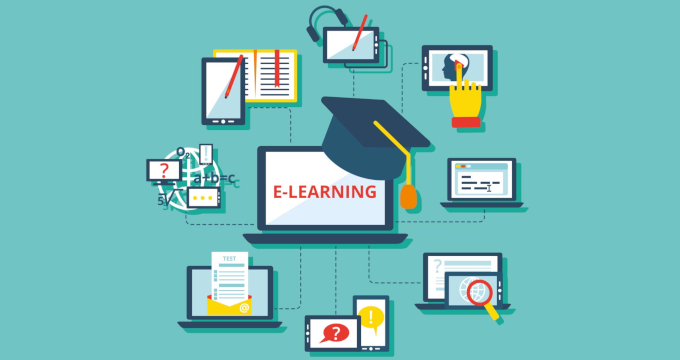The year 2020 has created a major incentive for both K-12 and the corporate sector to adopt e-learning. With over 1.2 billion children in 186 countries out of the classroom, the COVID-19 lockdown has forced educators to search for digital alternatives. Despite the numerous inconveniences of the online and hybrid format, e-learning has enabled educators to maintain a continuous learning process in the midst of the coronavirus outbreak.
E-Learning Challenges
So let’s take one more look at the e-learning challenges and achievements during the “worst year in history”. While the advent of e-learning has been underway long before COVID-19, on a global scale we were still unprepared in a number of ways for a massive online shift. The challenges we have been experiencing include:
Accessibility
At the very least, one needs Internet access and a computer to go to a virtual class, and a smartphone or a mobile device to install apps for e-learning. While students who are better off may have these possibilities, it is different for students from less privileged backgrounds. Some school districts provided their students with devices and Internet access, but in many cases, the adoption of e-learning has widened the digital divide.
Learner’s experience
While students are capable to partake in learning activities from the safety of their homes, the online format has somewhat compromised their learning experience. A lot of students complain about device fatigue and the necessity to take extra efforts to stay focused during lectures.
Learning efficiency
For older students e-learning may spell better education outcomes, yet younger kids have trouble concentrating on the tasks and avoiding distractions. Young children need discipline and structure – in most households, one of the parents had to give up work in order to supervise learning.
The negative social and psychological impact
It’s more to traditional education than simply learning – it also plays a major part in socializing and psychological well being. Throughout 2020, we had to deal with the psychological consequences of social isolation: students who miss their peers, and the campus lifestyle are likely to feel depressed and lose motivation.
Top E-Learning Trends of 2020
Yet, despite the obvious drawbacks of the digital format, e-learning is in a state of continuous improvement. With the coronavirus lockdown acting as a major catalyst, the e-learning approaches are getting more sophisticated. Needless to say, so does technology. Let’s now take a look at the progress of the e-learning industry in 2020 and its major achievements.
The rise of personalized learning
As it turns out, most students have a hard time concentrating during online lectures. Experiments have proved that diagnosing the individual knowledge gaps and giving students exactly the information they need to eliminate them works best in an online or hybrid learning scenario. A personalized learning approach improves learning outcomes, as students learn more effectively when the information they receive is tailored to their knowledge level.
The global personalized learning market was predicted to surpass $2 billion by 2024, but with COVID-19 as a major growth incentive, it is now expected to develop at a faster pace. In the corporate sector, educators are also adopting personalized learning, which helps workers upgrade their skills even if they are working remotely.
Read also: Lessons Learned From Distance Learning
Microlearning
Another dominant trend in 2020 was the continued proliferation of microlearning. Unlike traditional learning, microlearning involves feeding learning content in small chunks and in a range of formats. This approach matches an online environment where a student’s focus tends to wander and is fit for learners with limited time and short attention spans. It is also popular in the corporate sector since it enables learners to access learning content whenever they have time on their busy schedules.
Data-driven approach
The rise in personalized learning has created the demand for advanced tools for capturing, storing, and processing data. Not only does data play a crucial part in knowledge evaluation and progress assessment, but it also is capable of measuring the emotional response to learning content in order to improve the learning experience.
Increased use of data, sets the demand for advanced security solutions. With more and more people studying online, vendors need to take effective measures to ensure data protection.
Read also: How AI Transforms Knowledge Assessment Practices
Mobile learning
A CNBC study suggests that by 2025, ¾ of the world population will be accessing the Internet through smartphones. The lockdown has radically increased the use of mobile devices, the average screen time has increased, and so has the range of activities accessible through smartphones and tablets. Making learning content easily readable and accessible on mobile devices is now a market standard.
Social learning and peer-to-peer learning
Remote or hybrid learning takes a heavy toll on social interactions. Leveraging social learning helps improve this situation while increasing the level of social engagement. In 2020, K-12 teachers were increasingly encouraging students to split into small groups and share what they’ve learned with their peers.
The corporate sector has been increasingly adopting peer-to-peer learning and encouraging learners to also act as content creators. Apart from strengthening social bonds and bridging the skills gaps, such an approach helps employees to develop analytic, presentation, and persuasion skills.
Final Thoughts:
The 2020 e-learning trends are here to stay. Obviously, even though the schools and offices will reopen after the COVID-19 crisis, some learners will stick with digital learning. Globally, the e-learning market is set to reach $375 billion over the next 6 years, as reports Global Market Insights. Increased e-learning standards along with the development of technologies like AI, 5G, big data analytics, and cloud services, are now setting the stage for further sophistication of learning management systems like VARTEQ ReaLMS. Entrepreneurs willing to capture the rising trend will come up with more innovative ideas for e-learning apps and solutions.
Looking to develop e-learning tools for your business? Contact us now to schedule a free call with our experts.

